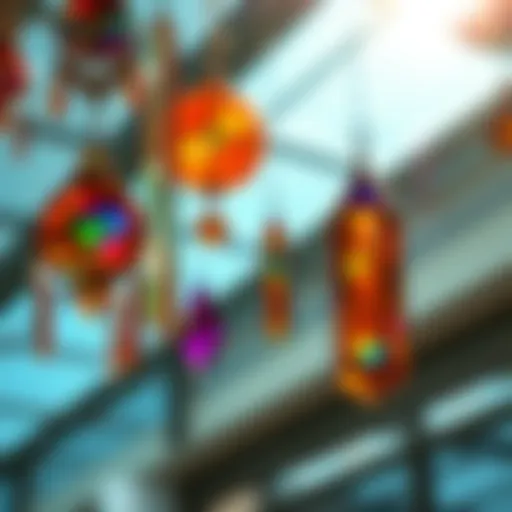The Casual Bow Tie: Elevate Your Modern Wardrobe
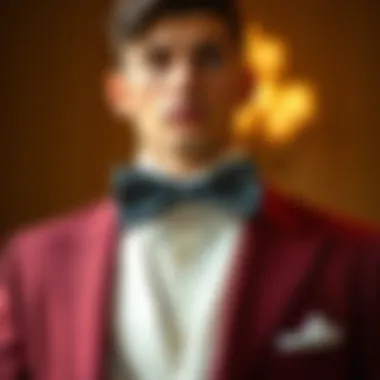

Intro
The casual bow tie has come a long way from its origins tied to formal occasions, transforming into a symbol of modern fashion flexibility. Once reserved for black-tie events, this accessory now finds itself gracing all sorts of settings, from casual get-togethers to artistic gatherings. It's not only about the fabric or the pattern, but how this seemingly simple addition can elevate a basic outfit, adding a touch of personality and flair. Understanding its history and versatility is key for today’s fashion-forward individual.
Fashion Tips
Styling Techniques
When it comes to wearing a casual bow tie, the styling possibilities are vast. The approach is easily adaptable, allowing it to be dressed up or down depending on the occasion. Here are some effective tips:
- Color Coordination: Choose colors that resonate with your outfit. A solid bow tie can anchor a busy pattern, while a patterned bow tie can enliven an otherwise monochromatic look.
- Layering: Incorporate the bow tie into layered looks. Paired with a tailored blazer over a simple tee, it seamlessly bridges the gap between leisure and sophistication.
- Knotting Style: Experiment with different knot styles, like the butterfly or diamond. Each knot conveys a different vibe and can subtly shift the overall presentation.
"The right bow tie can be the finishing touch that transforms an ordinary outfit into something quite extraordinary."
Must-Have Accessories
While the casual bow tie stands out on its own, it’s influential when combined with complementary accessories. Consider the following:
- Pocket Squares: A well-chosen pocket square can harmonize with your bow tie and lend an extra layer of sophistication.
- Casual Shoes: Footwear matters. A pair of loafers or clean, minimalist sneakers will pull together a relaxed look without compromising style.
- Eyewear: Stylish glasses – whether they're sunglasses or optical frames – can accentuate your features and provide a polished edge.
Outfit Inspiration
Seasonal Outfit Ideas
Different seasons bring diverse style opportunities. Here are a few ideas:
- Spring: Try pairing a light linen bow tie with a chambray shirt and soft beige chinos. Top off with a light cardigan for an effortlessly chic spring aura.
- Summer: A vibrant floral bow tie with a short-sleeve button-up shirt, combined with tailored shorts, creates a relaxed vibe perfect for BBQs or garden parties.
- Fall: Darker, richer colors in fabrics like wool work best during this season. Combine a plaid bow tie with a cozy sweater and navy trousers for a smart yet comfortable outfit.
- Winter: Opt for heavier fabrics like tweed. A muted bow tie works beautifully with a wool overcoat and a knitted scarf, blending style with warmth.
Versatile Wardrobe Essentials
To make the most of a casual bow tie, curate a wardrobe with essentials that complement its versatility. These might include:
- Tailored Blazers: Invest in a well-fitted blazer that can transition seamlessly from day to evening parties.
- Quality Dress Shirts: A range of dress shirts in different hues and patterns can be paired with various bow ties for endless combinations.
- Chinos: Comfortable yet polished, chinos serve as a great foundation for a range of outfits that incorporate a bow tie.
The casual bow tie is more than just an accessory; it’s an expression of style and personality. With the right choices, it can transform the ordinary into the extraordinary, making it a true staple in the modern wardrobe.
Preface to the Casual Bow Tie
The casual bow tie is a fascinating blend of classic elegance and contemporary casualness. This unique accessory has steadily made its way from formal events into the everyday wardrobes of style-conscious individuals. Understanding the casual bow tie's relevance today involves looking beyond its typical associations with tuxedos and formal attire. It embodies a certain charm that, when integrated wisely, can elevate one's personal style.
Definition and Characteristics
To start, a casual bow tie is distinct from its more formal counterparts primarily in its fabric, size, and overall style. Generally crafted from materials like cotton or linen, they often feature fun patterns or colors that diverge from the traditional solid hues associated with formal bow ties. Their flexibility in design—ranging from playful prints to textured fabrics—makes them an adaptable accessory. In a nutshell, casual bow ties embody a joyous spirit while still providing a touch of sophistication, making them suitable for a variety of occasions.
Characteristics include:
- Variety of Fabrics: Unlike classic silk bow ties, casual versions often utilize breathable materials.
- Playful Patterns: Dotted, striped or even floral designs are common, offering a vibrant feel.
- Adjustable Sizes: Many are designed with adjustable straps, adding to their comfort and ease of wear.
Historical Context
The bow tie has a long and rich history that predates casual styles by centuries. In the 17th century, Croatian mercenaries introduced a cloth tied around the neck to France, which evolved into what is now recognized as the modern necktie. By the 19th century, the bow tie started taking shape as a distinct fashion statement, primarily in aristocratic circles. The 20th century saw it further embraced in various fashion tribes—from early 1900s gentlemen to the hipsters of recent decades. This evolution reflects shifting sartorial norms and changing ideas about elegance and personal expression. Today, as casual dress codes gain traction in many environments, the bow tie has adapted, finding its place in both relaxed settings and professional realms.
Are you ready to explore how this accessory can seamlessly fit into modern wardrobes? Whether you’re a fashion designer or simply someone looking to freshen up their style, the casual bow tie speaks volumes without uttering a word.
Evolving Perceptions of Formality
The concept of formality has seen a significant transformation in recent years, shaped by the fluid nature of fashion and societal shifts. Understanding this evolution is crucial for anyone interested in integrating the casual bow tie into their wardrobe effectively. This section will delve into how dress codes have changed and the role casual bow ties play in professional settings, providing insights for fashion designers, stylists, and retailers.
The Shift in Dress Codes
Traditionally, dress codes were clearly defined, often segregating formal attire from casual wear. However, this distinction is becoming increasingly blurred. The rise of the smart casual trend has allowed men and women to express their individuality while still adhering to a level of professionalism. This shift indicates a broader movement toward acceptance of more relaxed fashion choices in various environments, including workplaces and social gatherings.
Many workplaces are adopting a more laid-back approach, allowing employees to wear items that promote comfort and expression, like casual bow ties. While once reserved for formal occasions, bow ties can now be spotlessly paired with casual blazers or sleek denim. The emergence of remote work and progressive dress norms has undoubtedly contributed to this change. People are prioritizing style and comfort, merging the two in ways previously thought unthinkable.
Casual Bow Tie in Professional Settings
While incorporating a casual bow tie into a professional outfit might still raise eyebrows in conservative industries, certain environments are rapidly embracing this unique accessory. Dressing for success no longer means sacrificing personal style. Industries such as tech, marketing, and creative fields have carved out a niche for relaxed yet polished attire.
In a professional setting, consider pairing a casual bow tie with a smart-casual shirt, tailored trousers, and loafers. This look strikes a balance between professionalism and personal flair. Notably, opting for rich colors or playful patterns can serve as a statement, showcasing character without crossing the line into eccentricity.
"The casual bow tie, when styled correctly, resonates with confidence and individuality in professional spaces. It has the power to elevate even the simplest of outfits."
However, one must always gauge the company culture before diving headfirst into new fashion norms. Understanding the dynamics of your workplace is key; what works in one sector may not land well in another. Therefore, experimentation with the casual bow tie should be approached thoughtfully—fitting the environment while still allowing for expression can create a compelling look that resonates well within broader informal themes of modern workplace fashion.
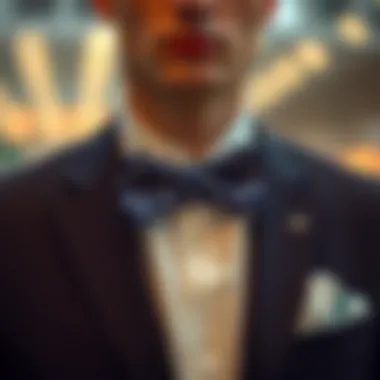

Styling the Casual Bow Tie
When we talk about the casual bow tie, it's not just about wearing a piece of fabric around your neck—a bow tie can dramatically change your outfit's vibe. The way you style this accessory plays an essential role in how you present yourself and express your individuality. It's the cherry on top, balancing the refined with the relaxed. This section will explore various ways to style a casual bow tie, looking into outfit pairings and layering techniques that both enhance your look and offer versatility.
Outfit Pairings
With Casual Shirts
Pairing a bow tie with casual shirts is a smart way to effortlessly elevate your look. Imagine a simple cotton button-up in a light shade, and how a bold-patterned bow tie could breathe life into it. One key characteristic of this combination is that it allows for creativity without being overly formal. Taking this route gives individuals a chance to play with colors and prints, adding flair while keeping it cozy.
The unique feature here is that casual shirts often come in various fabrics like chambray or flannel, which enhance comfort. However, they might lack the crispness of more formal shirts, so it’s vital to choose bow ties that complement this relaxed feel. A disadvantage could be if one chooses an overly flamboyant design, as it might clash rather than create harmony.
Pairing with Blazers
When it comes to combining a bow tie with blazers, we're stepping into a territory that balances smart and casual effortlessly. Blazers bring structure to an outfit, and adding a bow tie can infuse a sense of playful sophistication. The appeal of this combination lies in the contrast; the blazer’s tailored lines help the bow tie stand out, ensuring it’s not lost in the ensemble.
A striking aspect of this pairing is versatility; you can opt for a patterned bow tie to add color to a plain blazer or stick to a solid hue for a more classic look. But a unique advantage is that it allows room for personalization – with varying fabric types and textures, different vibes can be created from the same elements.
However, an over-the-top bow tie might risk appearing costume-like, which is essential to navigate carefully to maintain balance.
Integrating into Smart Casual Attire
The smart casual aesthetic is where the casual bow tie really shines. Mixing classic elements with a relaxed style, you can incorporate a bow tie into this dress code seamlessly. By doing so, you not only stand out but also demonstrate an understanding of fashion's subtle nuances. A bow tie here can convey an air of thoughtfulness without veering into overdressed territory.
A significant characteristic of smart casual attire is its flexibility; you can combine elements like chinos, loafers, and a lightweight knit sweater to create effortless elegance. This integration opens up a world of styles—like pairing a textured bow tie with a linen shirt and tailored trousers, integrating softness with sophistication. Still, it can be a double-edged sword as the line between smart casual and overly dressed can blur easily, and that's where attention to detail must be paramount.
Layering Techniques
Layering adds another dimension to how the bow tie can be styled. Whether you're dressing for fluctuating weather or simply wish to create depth in your outfit, layering techniques can make your bow tie an integral part of your look rather than an afterthought. The trick lies in the thoughtful selection of layers that enhance rather than overshadow your bowtie choice.
Simple additions like cardigans, vests, or even well-tailored coats can set the tone to match your bow tie's vibe while keeping you cozy and stylish.
Fabric Choices for the Casual Bow Tie
Selecting the right fabric for a casual bow tie is crucial for ensuring both comfort and style. The textile not only influences the overall look but also determines how the bow tie interacts with different outfits and occasions. Choosing the perfect fabric involves balancing factors like breathability, texture, and durability. Each fabric brings its own personality, which can either elevate or dampen an outfit. Understanding various materials available for bow ties can help individuals curate their wardrobe to reflect personal tastes while accommodating different social settings.
Commonly Used Materials
Cotton
Cotton bow ties are often hailed for their versatility and ease of care. This classic fabric is soft against the skin and allows for great breathability—making it a favored option for warmer climates or casual day outings. The key characteristic of cotton lies in its ability to hold dye well, resulting in vibrant colors and crisp patterns. This enhances the visual appeal of a casual bow tie, allowing individuals to express their personality.
One unique feature of cotton is its natural feel; it drapes well, offering a comfortable fit without being overly rigid, which is excellent for relaxed, modern aesthetics. While cotton is generally durable, it can wrinkle easily, which may require more frequent ironing. However, many of today’s cotton options come with wrinkle-resistant treatments, bridging the gap between practicality and style.
Linen
Linen bow ties are distinguished by their light and airy qualities. This fabric is particularly well-suited for the summer months due to its breathability and inherent moisture-wicking properties. The key characteristic of linen is its texture, giving a more relaxed and informal vibe, which aligns perfectly with the casual bow tie aesthetic. For those looking to embrace a more laid-back yet stylish appearance, linen is a solid choice.
A unique feature to note about linen is its natural imperfections—each piece may have variations that add character. This rustic charm appeals to fashion-forward individuals embracing authenticity in their wardrobe choices. Nevertheless, linen can be more susceptible to stains and is prone to wrinkling, which may not suit someone desiring a crisp look all day long.
Synthetic Blends
Synthetic blends have become a popular alternative due to their adaptability and ease of maintenance. Typically crafted from a mix of polyester, nylon, or other man-made fibers, these fabrics are durable and often wrinkle-resistant, making them a wise choice for those with busy lifestyles. Furthermore, they often hold their shape well, ensuring the bow tie looks sharp throughout the day.
The key characteristic of synthetic blends is their ability to replicate the feel and appearance of natural fibers while offering enhanced functionality. An appealing aspect is the wide variety of patterns and colors available, making it easy to find something that fits any occasion. However, some might find synthetic materials less breathable than cotton or linen, which could be a consideration during hot weather.
Seasonal Fabric Considerations
When it comes to fabric choices, understanding the seasons can significantly enrich the bow tie experience. Different fabrics work better depending on the climate, influencing not only comfort but also the overall aesthetic. For instance, lighter fabrics like linen or cotton are ideal for summer weddings or outdoor parties, while heavier blends can lend a more sophisticated touch during the cooler months as part of winter gatherings.
Being mindful about fabric seasonality allows individuals to make versatile choices that enhance their wardrobe's adaptability, ensuring the casual bow tie remains a beloved accessory year-round.
Occasions for Wearing a Casual Bow Tie
The casual bow tie stands out as a versatile adornment in contemporary wardrobes, offering a distinct aesthetic that can elevate even the simplest outfit. Its charm lies in its blend of formality and relaxed style, making it suitable for various occasions. Understanding the myriad of environments where a casual bow tie can shine is crucial for anyone wishing to incorporate this accessory into their fashion repertoire. The right bow tie can turn heads and spark conversations, showcasing a person's taste and personality.
Formal Events with a Twist
A casual bow tie can breathe new life into formal gatherings where traditional attire reigns supreme. Instead of the standard necktie or cravat, opting for a brightly colored or patterned bow tie can infuse a sense of creativity and playfulness into attire that might otherwise seem rigid. While attending weddings, galas, and corporate functions, wearing a casual bow tie signifies that one is ready to embrace elegance while also showcasing a flair for the unconventional.
Not only does it act as a conversation starter, but it also allows the wearer to express individuality in spaces often dominated by conformity. For instance, pairing a deep navy suit with a vibrant, floral-patterned bow tie could make an unforgettable impression, blending sophistication with a modern touch. An option for "dressing up'' with a hint of fun is always appreciated in environments that also value creativity.
Outdoor Gatherings
Outdoor events, ranging from casual picnics to garden parties, are another arena where the casual bow tie thrives wonderfully. It bridges the gap between relaxed vibes and a polished look that is perfect for mingling. The beauty of wearing a casual bow tie in natural settings is that it can be paired with a variety of fabrics—from lightweight cotton to breathable linen—making it adaptable for warm weather or breezy afternoons.
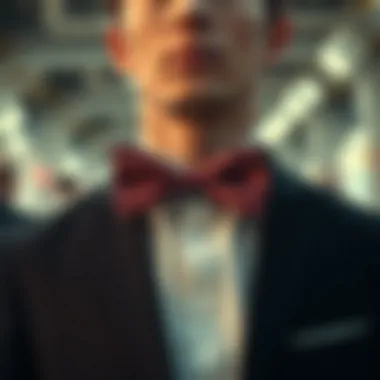

Imagine a summer wedding under the trees; a light blue checkered bow tie paired with a crisp white shirt and beige chinos exudes an effortless charm. Even a backyard barbecue can benefit from this accessory; it helps one stand out in a crowd of casual wear while still maintaining an approachable demeanor. For outdoor events, the key is to choose colors and patterns that harmonize with the surroundings while still making a stylish statement.
Everyday Casual Wear
In the realm of everyday fashion, a casual bow tie proves to be a unique alternative to more common accessories. It can elevate basic outfits into something special, making it easy to transition from day to night. Wearing a casual bow tie with pieces like a denim jacket, fitted trousers, or even a simple polo shirt adds an element of style that distinguishes the wearer from the crowd.
These versatile ties can be found in various fabrics and colors, allowing for a diverse range of pairings that suit different atmospheres. A smart-casual look can be achieved by teaming a light gray bow tie with a fitted white tee and dark jeans for a weekend brunch, while the same tie can be seamlessly integrated into a more laid-back office ensemble with chinos and a blazer. The casual bow tie becomes not just an accessory but a means of self-expression in everyday wore, showing that one values style even in a relaxed setting.
Color and Pattern Selection
Selecting the right color and pattern for a casual bow tie can make or break an outfit. The significance of this choice extends beyond mere aesthetics; it intertwines with the broader narrative of personal style and occasion appropriateness. The right color can complement a skin tone, while an appealing pattern can serve as a conversation starter or a statement of individuality. In essence, the color and pattern can enhance not only the bow tie’s visual appeal but also the overall ensemble, embodying the wearer’s personality and mood.
Understanding Color Theory
Color theory plays a crucial role in how we perceive combinations and the emotional response they evoke. It encompasses the science behind color mixing and the visual impact that colors have when placed side by side.
For instance, warm colors like red, orange, and yellow radiate energy and enthusiasm, making them ideal for casual events or gatherings. Conversely, cool colors such as blue and green often convey calmness and professionalism, suitable for work settings.
When choosing a bow tie, consider the color wheel, which helps in making complementary choices.
- Complementary colors, found opposite each other on the wheel, create a vibrant look.
- Analogous colors, next to one another, offer a more serene and cohesive appearance.
Further, incorporating neutrals can offer balance, which is especially helpful when bold colors or patterns are involved. By understanding how to combine hue, saturation, and brightness, one can select bow ties that amplify rather than clash with their outfits.
Popular Patterns and Styles
When it comes to patterns, each type tells its own story and fits certain personalities and occasions. Here’s a closer look at some popular choices:
Polka Dots
Polka dots are an iconic design that evoke a sense of fun while remaining classy. The key characteristic of polka dots lies in their playful, yet structured appearance, making them an easy choice for both casual and semi-formal settings.
Unique Feature: They come in various sizes and color combinations, allowing for personalization. This versatility can be beneficial for anyone looking to make a subtle impact.
However, it is worth noting that very small dots might get lost on darker fabrics from a distance, while larger dots can dominate an outfit. Thus, when opting for polka dots, finding a suitable proportion is essential.
Striped Designs
Striped designs can bring a sophisticated edge to the casual bow tie. Their primary appeal lies in their clean lines and the ability they have to elongate the appearance. Stripes can be vertical, horizontal, or diagonal, which introduces different vibes.
Key Characteristic: The sharpness of stripes works well in both relaxed and more polished settings, serving as a bridge between formal and casual environments.
However, one should be cautious; combining striped patterns with other prints can sometimes lead to visual chaos. A solid shirt with a striped bow tie often strikes the right balance.
Floral Patterns
Floral patterns are another trending choice, offering a way to embrace vibrancy. Often associated with femininity, floral designs are now increasingly popular among all genders, providing a refreshing touch to any wardrobe.
Key Characteristic: They can embody a sense of warmth and cheerfulness. It's an excellent choice for events like garden parties or brunches, where a bit of whimsy fits the mood perfectly.
Nevertheless, choosing the right floral design is vital; overly complicated patterns might detract from an outfit’s overall coherence. Ideally, floral bow ties should complement the broader outfit, rather than overwhelm it.
In the world of fashion, the choices we make about color and pattern can define our personal style and the messages we convey. Selecting a bow tie is not just about standing out; it's a nuanced decision reflecting one's identity.
Maintaining Your Casual Bow Tie
Maintaining a casual bow tie is essential for ensuring that this distinctive accessory remains a staple in your wardrobe over time. The unique character of a bow tie, particularly one designed for a more relaxed or semi-formal occasion, can often be overshadowed by its care requirements. Proper maintenance safeguards its integrity and aesthetic appeal, making it an investment rather than just an accessory. Furthermore, keeping your bow tie in good condition also reflects a broader commitment to personal grooming and style.
When you think about it, a well-maintained bow tie can elevate even the simplest outfit — a shirt and jeans combo can instantly gain a touch of sophistication. However, neglecting its care can lead to an appearance that’s less than desirable, which ironically detracts from the very image you seek to project. Therefore, understanding how to clean, care for, and store your bow tie becomes not just desirable, but crucial.
Cleaning and Care Tips
Cleaning your bow tie is an important step in maintaining its look and longevity. Here are some pointers to keep in mind:
- Check the Label: Before taking any steps, it's wise to inspect the care label for specific instructions. Fabrics like silk demand delicate handling, whereas cotton or linen might be more forgiving.
- Spot Cleaning: For minor stains, using a soft cloth dampened with mild detergent can work wonders. Lightly dab the area rather than rubbing to avoid damaging the fabric.
- Hand Wash When Necessary: If a thorough clean is required, consider hand washing it in cold water with a gentle detergent. Agitate gently — no one wants a bow tie that looks like it’s run a marathon.
- Air Dry: Never wring out or put your bow tie in a dryer. Instead, lay it flat on a clean towel to air dry, reshaping it as necessary. This method helps preserve its shape and fabric integrity.
Storage Recommendations
Storing your casual bow tie properly is equally as critical as cleaning it. Improper storage can lead to unwanted wrinkles and misaligned shapes. Here’s how to keep your bow tie in tip-top condition:
- Use Bow Tie Hangers: If you have several bow ties, consider investing in a designated hanger. This not only keeps them organized but also ensures they hang freely, avoiding creases.
- Avoid Tight Spaces: Stuffing your bow tie into a drawer can cause it to lose shape. Instead, opt for a storage box with sufficient room, or drape it over a rod. That way, it can maintain its form until you’re ready to wear it.
- Keep Away from Direct Sunlight: Prolonged exposure to sunlight can fade the vibrant colors of your bow tie. Choose a dimly lit area for storage to preserve its vivid hues.
"A well-tended bow tie is more than just a piece of fabric; it's an expression of personal style and meticulousness."
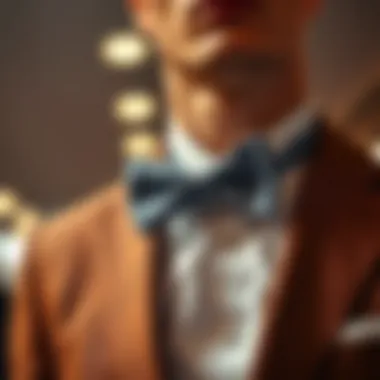

Performing regular maintenance, from cleaning to thoughtful storage methods, will pay dividends in the long run. Remember, a little effort goes a long way in preserving the charm and elegance of your casual bow tie.
Personalizing Your Casual Bow Tie Look
When it comes to adding a personal touch to fashion, the casual bow tie stands out as one of the most distinct accessories. Personalizing your look with a bow tie isn't just an afterthought; it's a deliberate choice that can enhance your overall style. This segment dives into how individualized options and thoughtful accessorizing bring depth to your attire and reflect your personality.
Customized Options
Monogramming
Monogramming has become a signature move in personalizing accessories, including bow ties. This craft involves embroidery or printing of initials, which can lend a tailored feel to an otherwise standard item. One key characteristic of monogramming is its potential to make an accessory feel distinctly yours; it showcases individuality and by extension, attention to detail. For those looking for something beyond run-of-the-mill, adding initials can evoke a sense of uniqueness and elegance to your outfit.
The benefits of monogramming include not just personalization, but also a hint of sophistication. It's a conversation starter, often drawing compliments or queries about the creative choice. One downside, however, could be the cost associated with customization. Some might find the extra expenditure less justifiable for an accessory, depending on their budget.
Unique Designs
In a world where being different is celebrated, unique designs play a crucial role. This aspect explores artistic styles that push the conventional boundaries of bow ties. A key characteristic of unique designs is their ability to tell stories; they can be inspired by art, culture, or personal experiences. Opting for a bow tie with a unique design rarely goes unnoticed. It speaks volumes about your personality and creativity.
The appeal of these designs is twofold. On one hand, they allow for bold expression without needing to compromise comfort. However, one should consider the unique feature of wearability. Some intricate designs may be suitable for informal settings, but find less acceptance at formal gatherings. Striking the right balance is key to maximizing the advantage of unique patterns as a personal flair.
Accessorizing Beyond the Bow Tie
Watches
A watch is often seen merely as a timekeeping device, but for many, it represents a statement of style. Wearing a sophisticated or vintage watch alongside a casual bow tie can elevate your look, tying your entire outfit together. The key characteristic of watches is that they bridge both functionality and style seamlessly. They can range from sleek leather bands to metallic, sophisticated designs.
Adding a watch can provide a polished look, reinforcing the notion of being fashionable yet practical. Nevertheless, it’s essential to select timepieces that complement—not overshadow—the bow tie. Balancing these accessories is crucial to prevent clashing styles.
Cufflinks
Cufflinks have historically been a symbol of elegance and refinement. When paired with a casual bow tie, they provide an opportunity for added flair. The key characteristic of cufflinks is their versatility; they come in an array of shapes, materials, and colors, which allows for creative expression. Cufflinks can either be understated or bold, depending on the desired look.
In terms of benefits, cufflinks can truly highlight the persona behind your outfit, making you appear prepared and attentive to detail. On the downside, they can feel like an unnecessary embellishment for some, particularly in ultra-casual settings. That said, when chosen wisely, cufflinks can perfectly harmonize with your bow tie, stylizing an otherwise simple outfit into something special.
Cultural Perspectives on Bow Ties
The casual bow tie, while often seen as a niche accessory in some fashions, carries a significant cultural weight across various societies. Its relevance goes beyond mere aesthetics—it's a tapestry of historic resonance and modern innovation woven together over centuries. Understanding these cultural perspectives equips fashion designers, stylists, retailers, and marketers with deeper insights into the potential of bow ties as versatile artifacts that can transcend more than just clothing.
Global Variations
Bow ties manifest uniquely around the world. In America, they are often seen on both young professionals trying to break from the traditional suit-and-tie mold and older gentlemen attending formal gatherings. These ties are generally worn with a smart casual ensemble, incorporating creativity and character into established norms.
Moving across the Atlantic, the European approach varies dramatically. For instance, in France, a bow tie is often synonymous with refinement and artistic flair, frequently donned by the avant-garde crowd and in sectors like the culinary arts. Italian interpretations lean more into fashion statements, showcasing flamboyant patterns or exquisite tailoring—it's not unusual to see a contrasting bow in the midst of a well-coordinated outfit.
In Japan, the bow tie holds a more ceremonial connotation. Smartly tied, they are a staple during special functions��—combining traditional craftsmanship with contemporary fashion, allowing individuals to express their identity without overshadowing local customs. This kind of stylistic nuance signifies respect, not just for the occasion but also for the people in it.
"Fashion is about comfort and finding your voice. In many cultures, the bow tie serves as that statement piece, allowing one’s personality to shine without the loudness of trends."
Thus, the global variations of bow ties highlight their adaptability and the integral role they can play across different contexts. The versatility of bow ties allows them to traverse boundaries—forming connections between cultures while being redefined by each.
Symbolism in Different Cultures
The symbolism attributed to the bow tie varies, often reflecting wider societal values and attitudes. In Western cultures, wearing a bow tie might suggest sophistication or a penchant for quirky individuality. It can represent a break from the traditional necktie—an attempt to carve out one’s style, placing an emphasis on personality rather than conformity.
In contrast, in some Asian cultures, the symbolism attached to bow ties carries a rather formal essence. Here, it can denote respect, particularly in professional settings or ceremonial events. The shape of the bow tie, an elegant contrast to regular ties, could even symbolize the balance of dualities—fitting into the dualistic views often prominent in Eastern philosophies.
Moreover, in African cultures, the bow tie can be a beacon of cultural pride, showcasing local artisanship and craft. Bow ties made from vibrant fabrics with intricate designs are not merely fashion choices; they become narratives interwoven with tradition, history, and communal identity.
Taking these diverse cultural perspectives into account enriches the dialogue surrounding the casual bow tie. This accessory, simple yet layered with meaning, can enhance a wardrobe in ways that reflect personal style while honoring cultural heritages.
The Future of the Casual Bow Tie
The future of the casual bow tie appears promising, as shifts in fashion trends continue to cultivate a greater acceptance of diverse looks. Not just an accessory reserved for formal occasions, the casual bow tie is emerging as a bold statement piece in everyday fashion.
Emerging Trends
Modern fashion is always evolving, and the casual bow tie is catching the wave of these changes. Designers are experimenting with bolder, unconventional patterns, and unique fabrics which can change a simple outfit into something extraordinary. The following trends have been garnering attention:
- Bright Colors: More people are leaning towards vibrant colors that stand out and express individual personalities. Gone are the days of solely muted or neutral tones. Now, shades like electric blue and sunset orange are being embraced.
- Playful Patterns: The rise of prints that play with geometrical designs, abstract art, and even nature has found its place in casual bow tie styles. Think of quirky shapes and lively motifs – they add an element of surprise.
- Mix and Match Styles: A trend that encourages wearing different materials and patterns together. People are beginning to mix cotton with linen or showcasing multiple patterns in one outfit, where a bow tie can essentially unify the look.
As these trends permeate deeper into mainstream fashion, the casual bow tie will only further solidify its place as a versatile accessory, able to transition from a relaxed gathering to a more polished setting with ease.
Sustainability in Bow Tie Production
With an increasing focus on sustainability in fashion, the production of casual bow ties is also adapting to meet these demands. Consumers today are more conscientious of their buying habits, seeking quality over quantity. Here's how sustainability is starting to shape the future of bow ties:
- Eco-Friendly Materials: Designers are exploring fabrics made from organic cotton, hemp, and recycled materials. These choices not only reduce environmental harm but often bring a unique textile feel that adds richness to the accessory.
- Ethical Manufacturing: Brands are now prioritizing ethical practices, ensuring that their production processes are fair and free from exploitation. Transparency in sourcing and labor practices can build trust and loyalty with consumers.
- Longevity Over Fast Fashion: Emphasizing quality over transient trends has become imperative. The idea is to create bow ties that can withstand the test of time rather than being tossed aside after a season. Customers appreciate investing in pieces that offer longevity both in style and wear.
Sustainability in bow tie production is not merely a trend; it represents a shift in consumer desire for fashion that respects both people and planet.
Overall, the trajectory of the casual bow tie intersects beautifully with evolving trends and a growing commitment to sustainability. As this accessory continues to adapt, it will undoubtedly retain its charm and relevance in the fashion world.









